YouTube Analytics Tools: 10 Best Tools to Benchmark and Optimize Your Channel Performance in 2025
Check out some of the best YouTube analytics tools on the market today that can take your channel performance to the next level.

With over 2 billion monthly active users, YouTube has become the world’s second-largest search engine.
Businesses are rushing to stake their claim on YouTube, and for good reason. But hitting ‘Upload’ isn’t enough. You need a data-backed content strategy.
One way to create that strategy is to utilize YouTube analytics.
YouTube analytics provide the roadmap to channel growth, revealing not just what content performs best, but why it resonates with your audience. From uncovering the optimal posting times to identifying the content gaps your competitors are missing, the right analytics approach can transform your YouTube strategy from guesswork into a science.
But to be able to do that, you need the right tools in your toolbox. In this guide, I’ll show you the different types of YouTube analytics tools and how to choose the right one for your business.
Key takeaways
-
YouTube’s native analytics is the best place to start. It’s free and gives solid insights into views, engagement, and audience behavior.
-
Upgrade to third-party tools when you need deeper insights, competitor tracking, or advanced features like A/B testing and cross-platform data.
-
Decide on your goals, budget, and key features you would require before beginning your search.
-
Choose tools that pull accurate, verified data directly from YouTube and update it frequently for reliable decision-making.
-
Reviewing analytics regularly helps you spot trends early, improve your content, and grow your channel strategically.
-
Advanced tools can guide you on what’s working, what needs fixing, and where you stand compared to competitors.
What are YouTube analytics tools?
YouTube analytics tools are specialized software platforms designed to collect, analyze, and visualize data about your YouTube channel and video performance. Unlike general social media analytics tools that provide surface-level metrics across multiple platforms, YouTube analytics tools dive deep into the unique aspects of video content performance, audience behavior, and the YouTube algorithm’s impact on content distribution.
These tools collect various types of data, including viewer demographics, watch time patterns, engagement rates, traffic sources, and revenue metrics for monetized channels, and then they transform this raw data into actionable insights that help marketers understand what drives views, subscriptions, and engagement on their channels.
Core functions of YouTube analytics tools
1. Performance tracking and monitoring. YouTube channel analytics tools continuously monitor key performance indicators like views, watch time, subscriber growth, and engagement rates. This real-time and historical data helps creators understand content performance trends and identify successful content patterns.
2. Audience insights and demographics Get detailed breakdowns of your audience, including age groups, gender distribution, geographic locations, device preferences, and viewing behaviors. Understanding your audience demographics helps tailor content strategy and optimize posting schedules.
3. Content optimization recommendations. Advanced analytics tools analyze your content performance and provide actionable recommendations for improving titles, thumbnails, descriptions, and tags. Some tools even offer A/B testing capabilities to optimize these elements systematically.
4. Competitor analysis capabilities. While YouTube’s native analytics are a great starting point, they have one major drawback—they only show your own channel data. Third-party YouTube video analytics tools can provide insights into competitor performance, helping you identify industry benchmarks and content opportunities your competitors might be missing.
5. ROI measurement for YouTube marketing. For businesses using YouTube as a marketing channel, these tools help measure return on investment by tracking metrics like cost per view, conversion rates, and revenue attribution from YouTube traffic.
Why YouTube analytics matter for brands
YouTube analytics have evolved from a nice-to-have into a strategic necessity. The platform’s massive reach and sophisticated algorithm create both unprecedented opportunities and complex challenges that require data-driven approaches to navigate successfully.
Understanding your audience
YouTube analytics provide granular demographic insights that go far beyond basic age and gender data. You can discover viewer behavior patterns, including when your audience is most active, what devices they prefer, and how they discover your content. This information enables you to create more targeted content and optimize posting schedules for maximum reach.
The platform’s analytics also reveal content preferences and engagement patterns unique to your audience. You can identify which video formats generate the highest engagement, what topics resonate most strongly, and how viewer attention spans vary across different content types. These insights allow you to refine your content strategy based on actual viewer behavior rather than assumptions.
In the example below, you can see that Emirates posts most frequently about Safety & Security Updates. However, the videos with the highest engagement, by far, are those that reveal Behind-the-Scenes content. So, if I were a social media manager for Emirates, I would use this insight to update my content strategy.
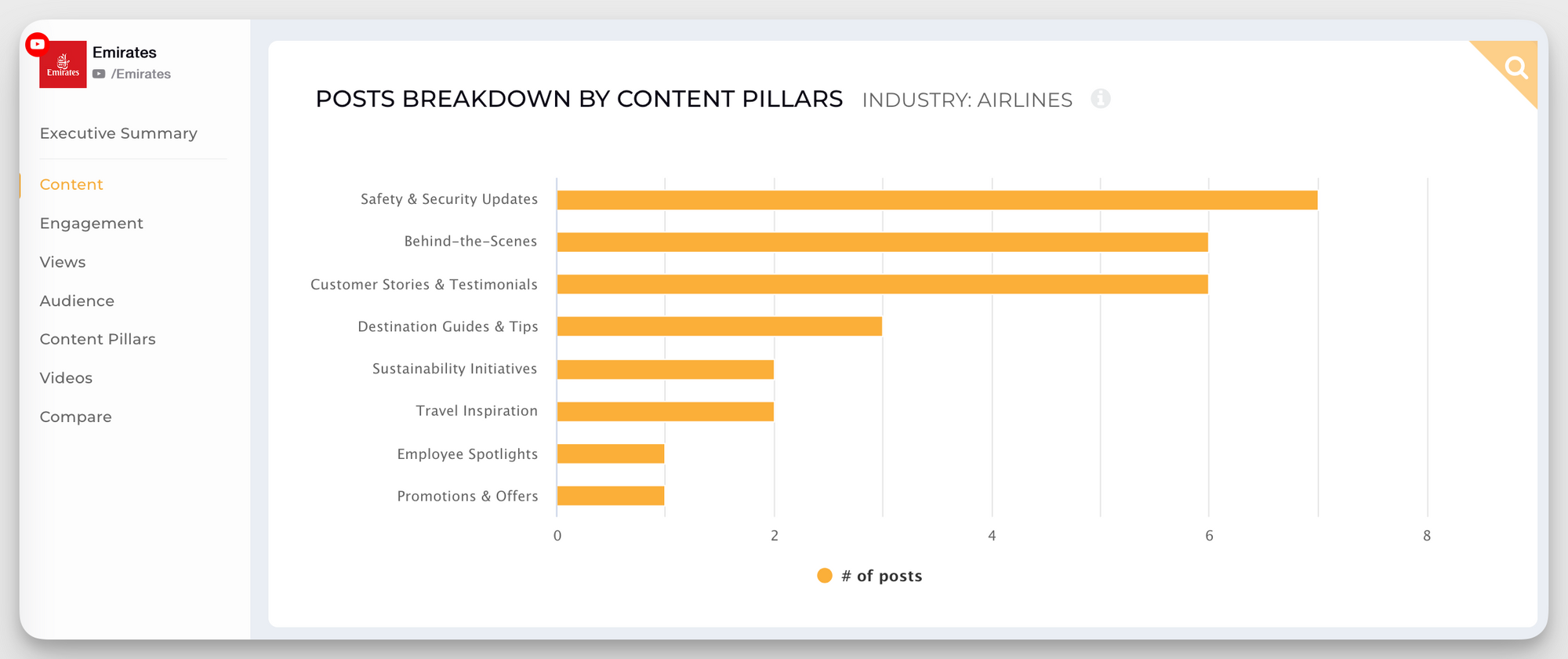
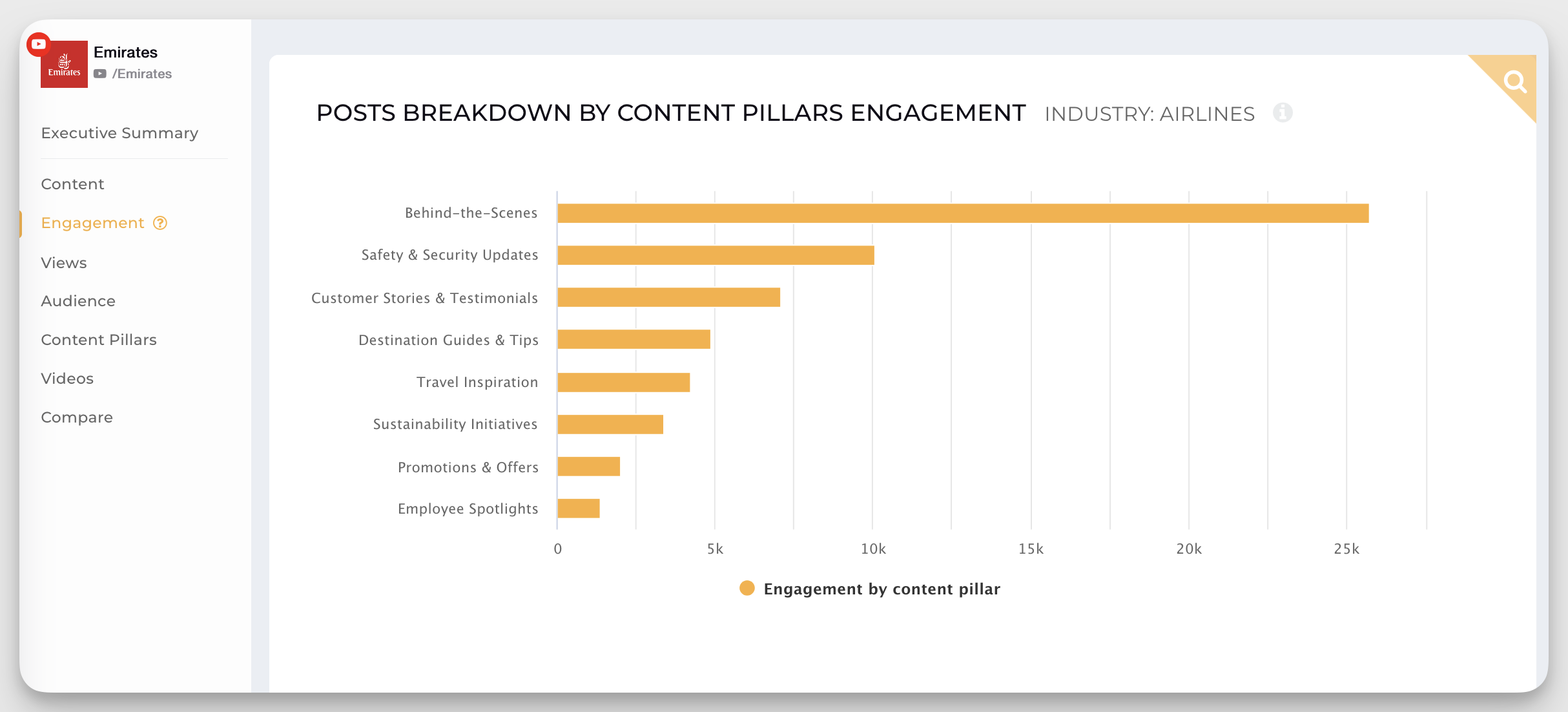
Content performance optimization
YouTube analytics enable sophisticated video performance analysis that goes beyond simple view counts. For example, audience retention graphs show exactly when viewers lose interest, helping you identify content elements that need improvement. Thumbnail click-through rates and title performance data reveal which creative approaches most effectively capture audience attention in YouTube’s crowded ecosystem.
Understanding how the YouTube algorithm responds to your content is crucial for organic growth. Analytics show how your videos perform in YouTube’s suggested video placements, search results, and browse features, enabling brands to optimize their content for better algorithm performance and increased organic reach.
Channel growth strategy
For sustained YouTube success, brands need to understand what drives subscriber growth beyond individual video performance. Analytics reveal which content types convert viewers into subscribers most effectively, and which traffic sources bring the most valuable long-term audience members.
One way you can do this using Socialinsider is by publishing the same content topic in two formats–long-form video and YouTube Short–and seeing which format has the highest engagement. Additionally, you can also look at your subscriber growth rate immediately after posting each video (I recommend waiting at least one week between posts so the data is as accurate as possible) to see which one earned you more subscribers.
YouTube analytics also help identify trending topics within your specific niche before they become oversaturated. By analyzing search terms, suggested video performance, and seasonal content patterns, brands can create timely content that captures emerging audience interests and drives significant organic growth.
Competitive intelligence
Perhaps most importantly for brands, third-party YouTube analytics tools provide competitive intelligence that’s impossible to obtain through YouTube’s native analytics alone. You can benchmark your channel performance against industry competitors, identify content gaps in your market, and discover successful strategies your competitors are using.
This competitive analysis helps you understand your share of voice within your industry, identify underserved audience segments, and spot emerging trends before competitors capitalize on them. If you’re serious about YouTube growth, access to competitive data often makes the difference between following industry trends and setting them.
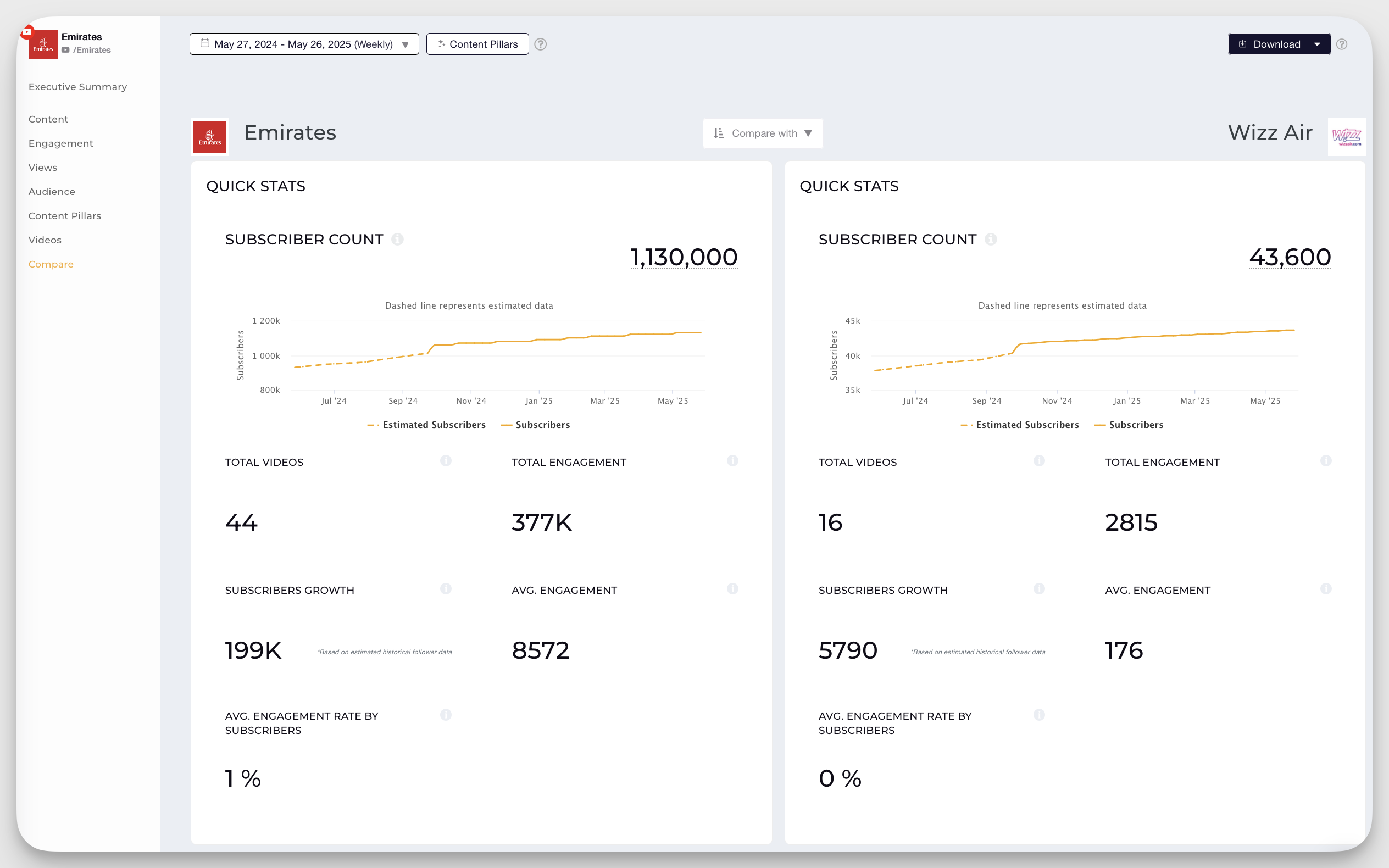
YouTube’s built-in analytics: Your free starting point
Curious why some videos take off while others flop? YouTube’s built-in analytics holds the clues. And it’s already at your fingertips.
YouTube Studio Analytics Overview
To access YouTube analytics, go to studio.youtube.com on desktop and log in to your YouTube channel.
If you’re on YouTube already, click on your profile icon and select YouTube Studio.
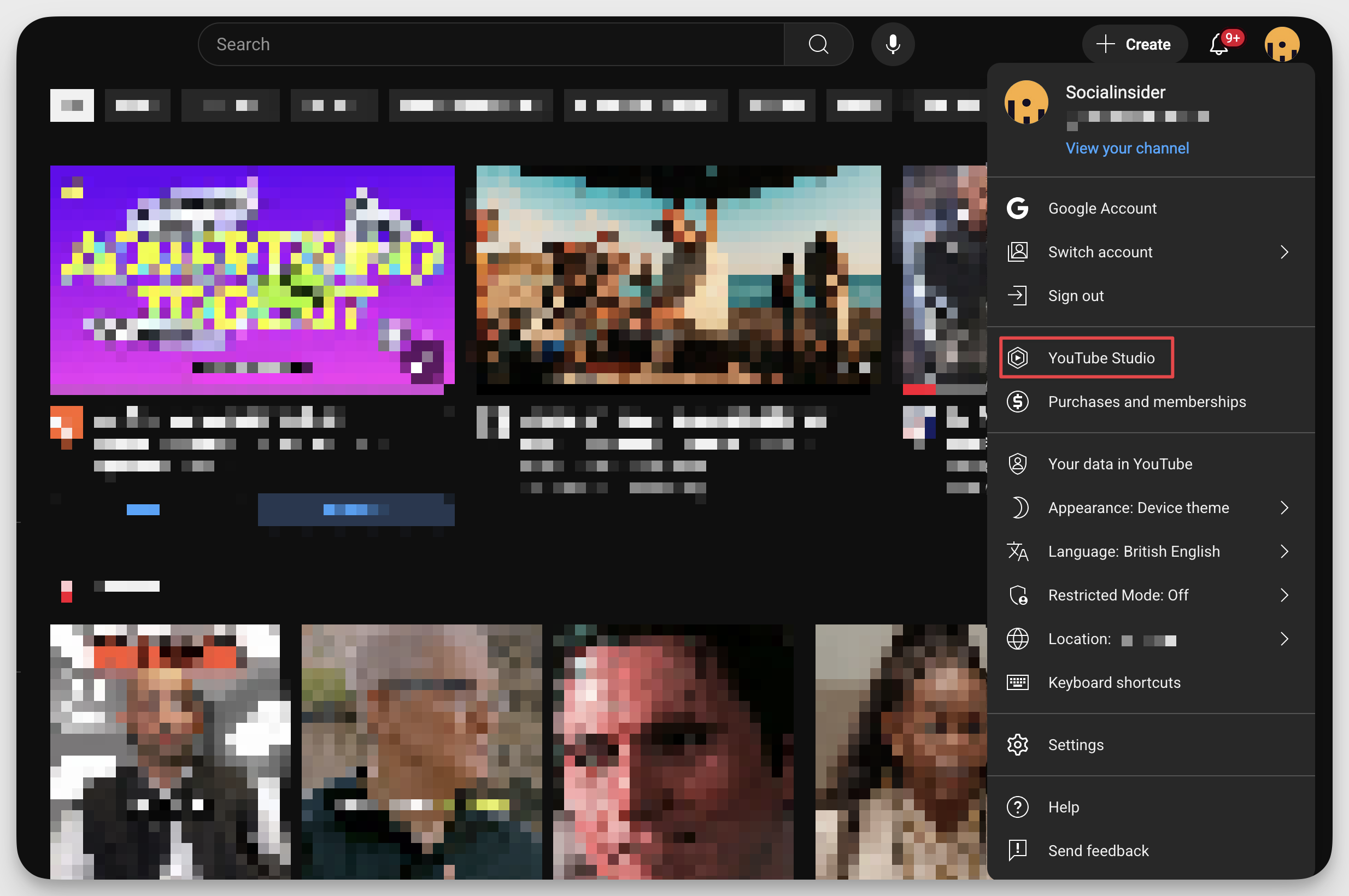
Once inside YouTube Studio, you’ll land on the Dashboard, which will show a quick overview of recent performance and key stats like views, watch time, and top videos.
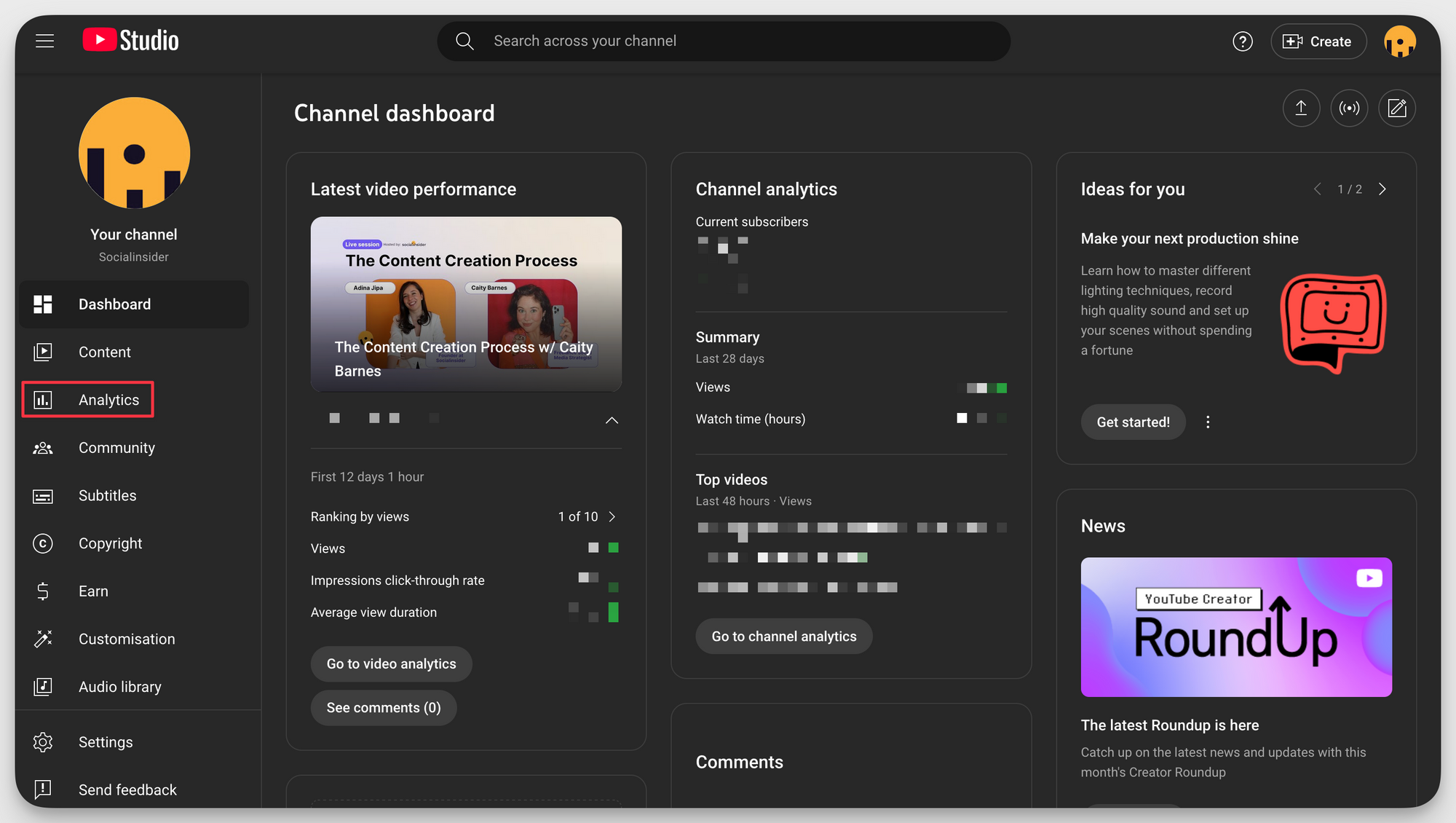
To access deeper insights, click Analytics from the left-hand menu.
You’ll see tabs like:
- Overview: high-level stats and recent trends
- Content: performance of individual videos
- Audience: who’s watching and when
- Revenue: earnings if monetized
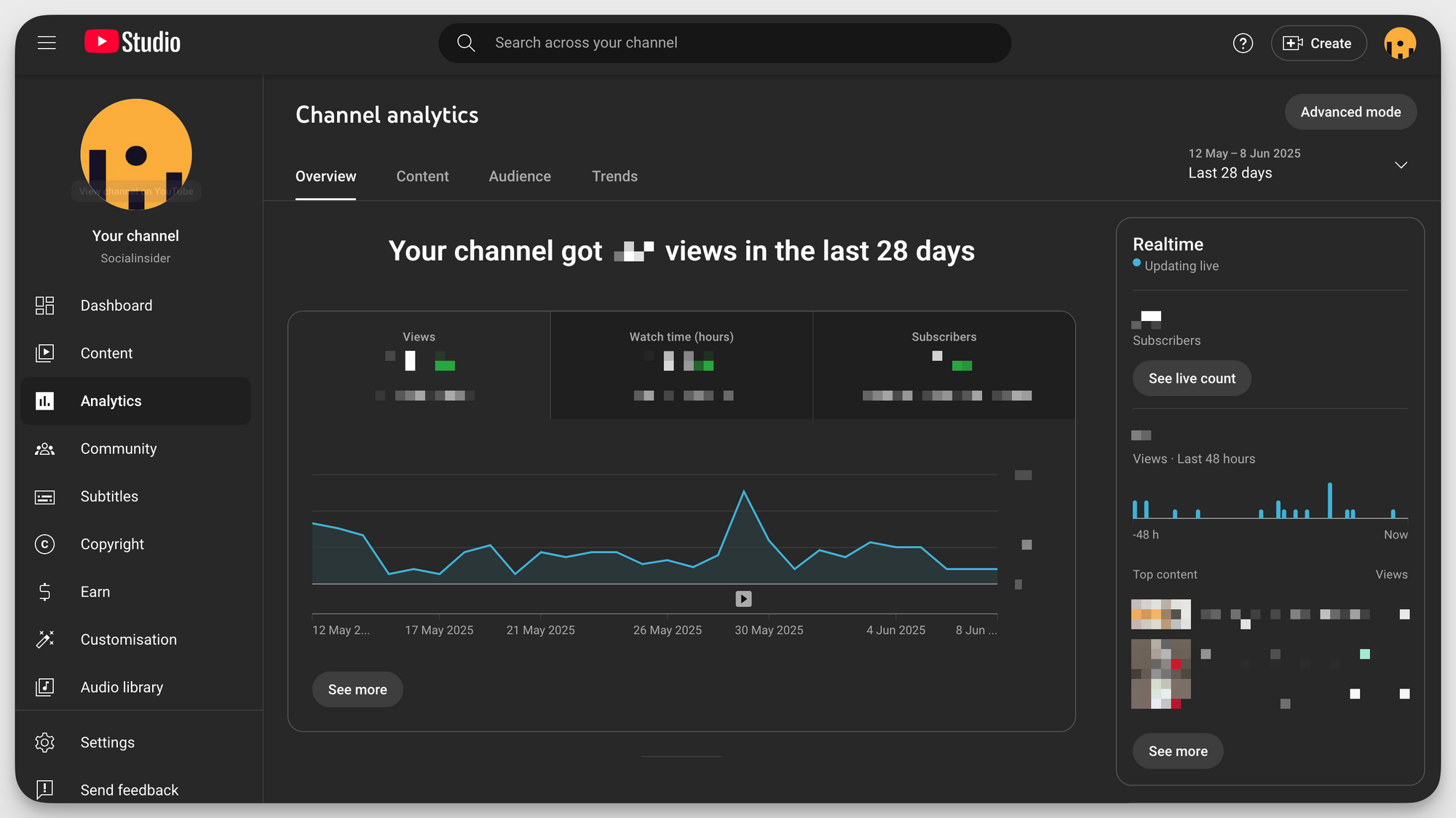
If you’re on mobile, you can download the YouTube Studio app that offers much of the same data as the desktop version.
Essential built-in metrics
- Watch time vs. views: Views count how many times your video is played. Watch Time measures how long people watch, which is critical for YouTube’s algorithm.
- Audience retention: Reveals where viewers drop off. It helps identify the strongest and weakest parts of your video.
- Traffic sources: Shows where your views are coming from, like search, suggested videos, or external links, so you can focus on what’s working.
- Demographics: Breaks down viewer age, gender, and location, letting you tailor content and posting schedules.
- Revenue analytics: For monetized channels, shows earnings, RPM (revenue per mille), and which videos bring in the most revenue.
Advanced features in YouTube Studio Analytics
- Real-time analytics: Track video performance as it happens, with minute-by-minute data for the last 60 minutes and hourly data for the past 48 hours.
- Compare metrics across time periods: Spot trends by comparing views, engagement, and other YouTube metrics across different date ranges.
- Custom filters: Dive deeper into performance by filtering data by content type, geography, traffic source, and viewer segment.
- Export capabilities: Download your analytics data into spreadsheets for detailed reporting, team sharing, or deeper analysis outside YouTube Studio.
Limitations of native YouTube analytics
Unlike other social platforms, YouTube’s native analytics are quite comprehensive. However, while you can extract meaningful insights about your channel, you can’t benchmark your performance against competitors or industry peers because you don’t have access to their data.
That’s where third-party social media analytics tools like Socialinsider come in handy. You can get competitor insights, cross-channel comparisons, and benchmarks against industry standards.
You also don’t miss out on broader campaign tracking and platform integrations.
Socialinsider’s free YouTube analytics tool
For a fast way to analyze any public YouTube channel, Socialinsider’s Free YouTube Analytics Tool is a powerful option that gives you instant access to essential metrics like average views per video, engagement rate, and top-performing content. Whether you’re tracking your own channel or doing competitor research, this free tool is a quick and reliable way to uncover actionable insights.
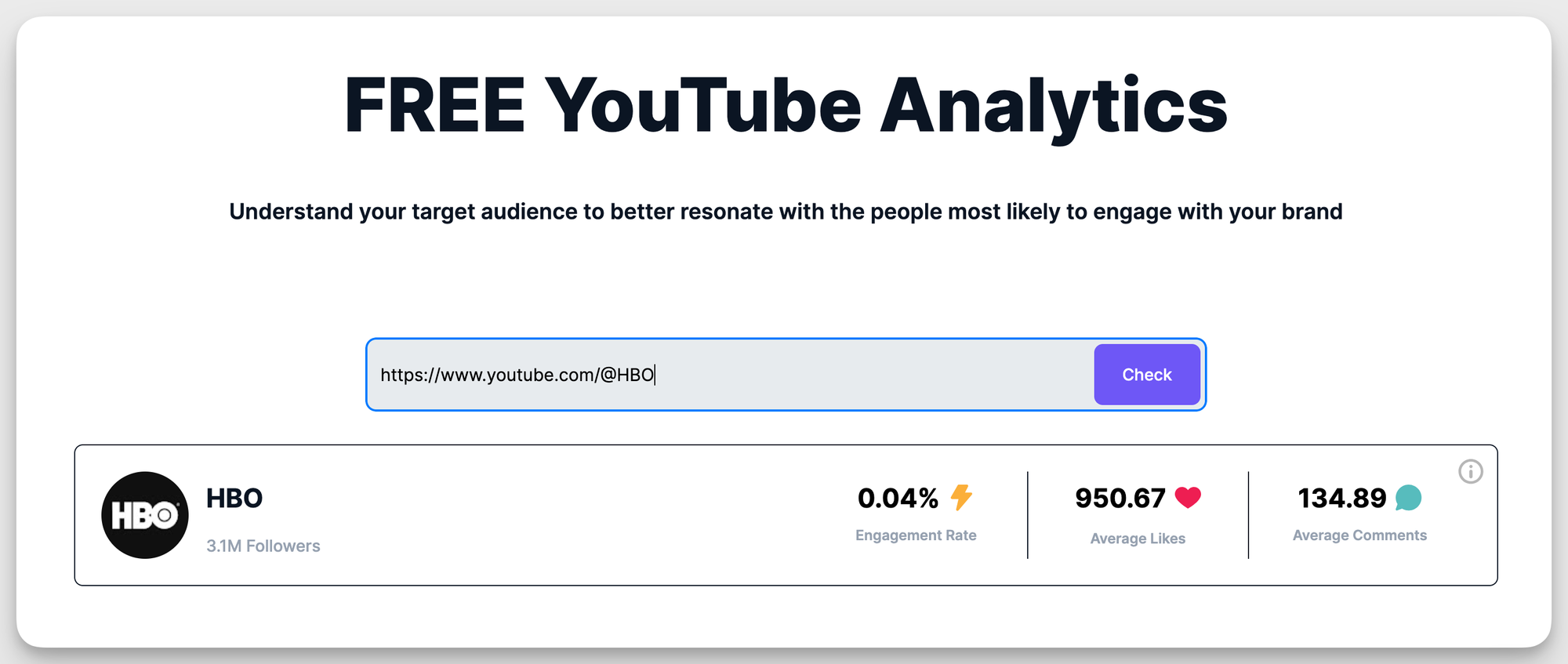
10 third-party YouTube analytics tools
We’ve seen how powerful native analytics can be, but also their limits. To overcome these gaps, here are the 10 best YouTube analytics tools that can take your YouTube strategy to the next level.
For advanced analytics and competitive benchmarking
1. Socialinsider
Socialinsider is a powerful social media analytics platform that offers detailed YouTube insights, covering both long-form videos and Shorts. It tracks key engagement metrics, subscriber growth, and content performance, helping users understand what resonates with their viewers.
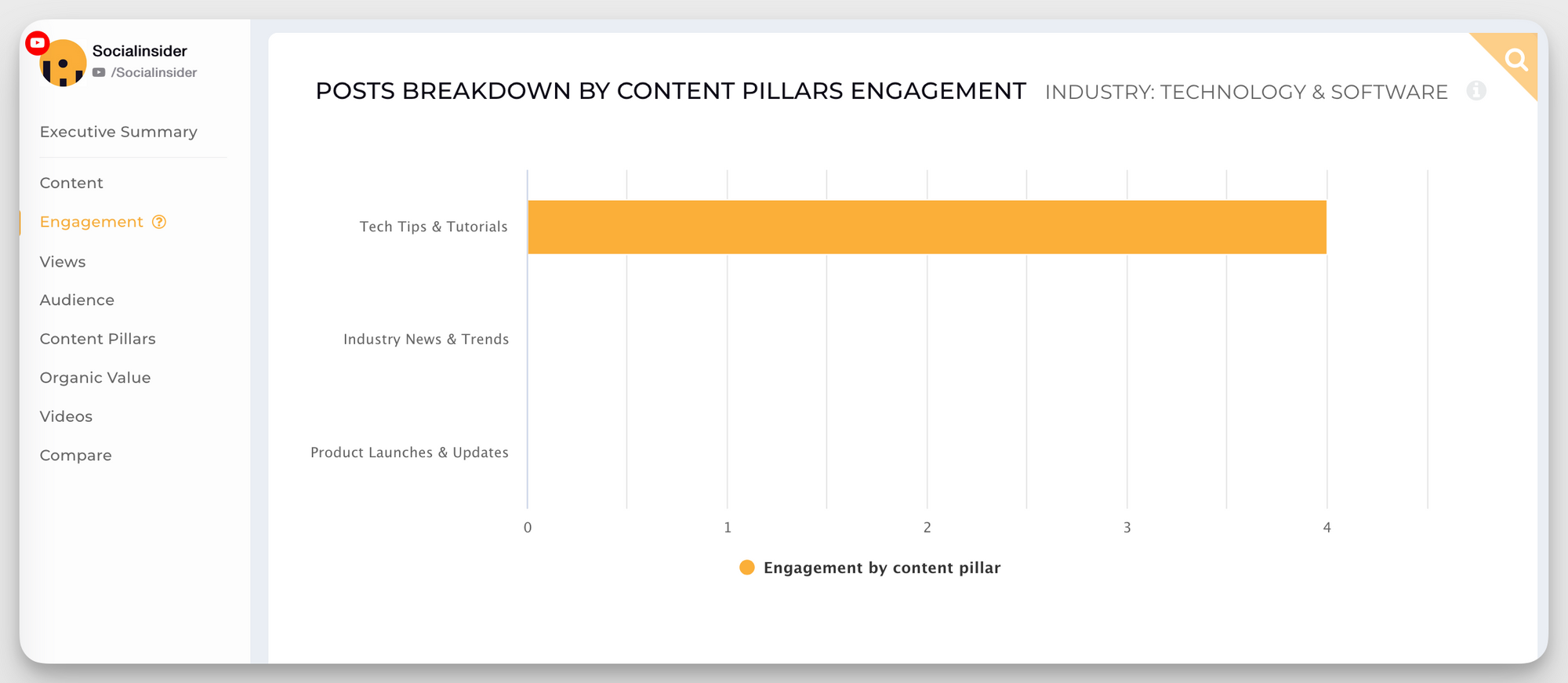
Additionally, Socialinsider supports automated reporting and provides historical data analysis, making it a valuable tool for marketers seeking to optimize their YouTube content strategy.
Key features:
- Cross-platform analytics: Socialinsider lets you collect and view data from all your social media channels in one easy-to-use dashboard.
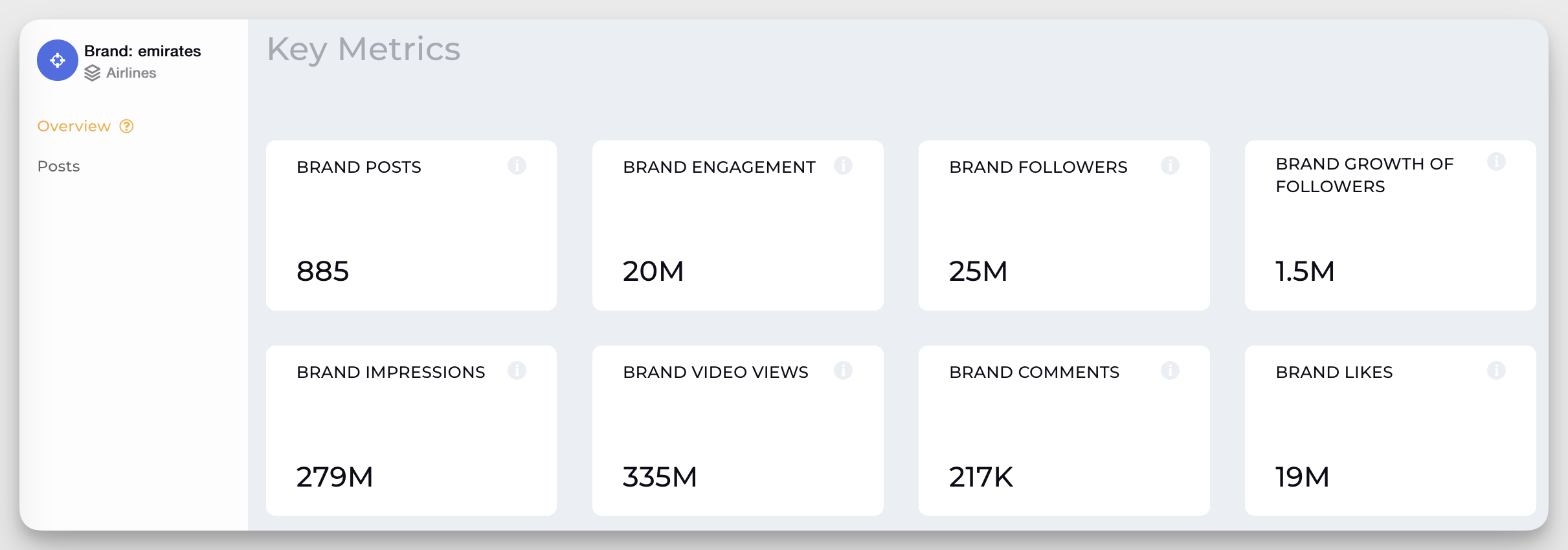
- Competitor benchmarking: You can compare your social media results with competitors or industry leaders to identify strengths, weaknesses, and opportunities.
- Content performance analysis: The platform breaks down how each post or video performs, helping you understand what type of content resonates best with your audience.
- Automated reporting: Socialinsider generates regular reports automatically, making it easy to share insights with your team or clients without manual effort.
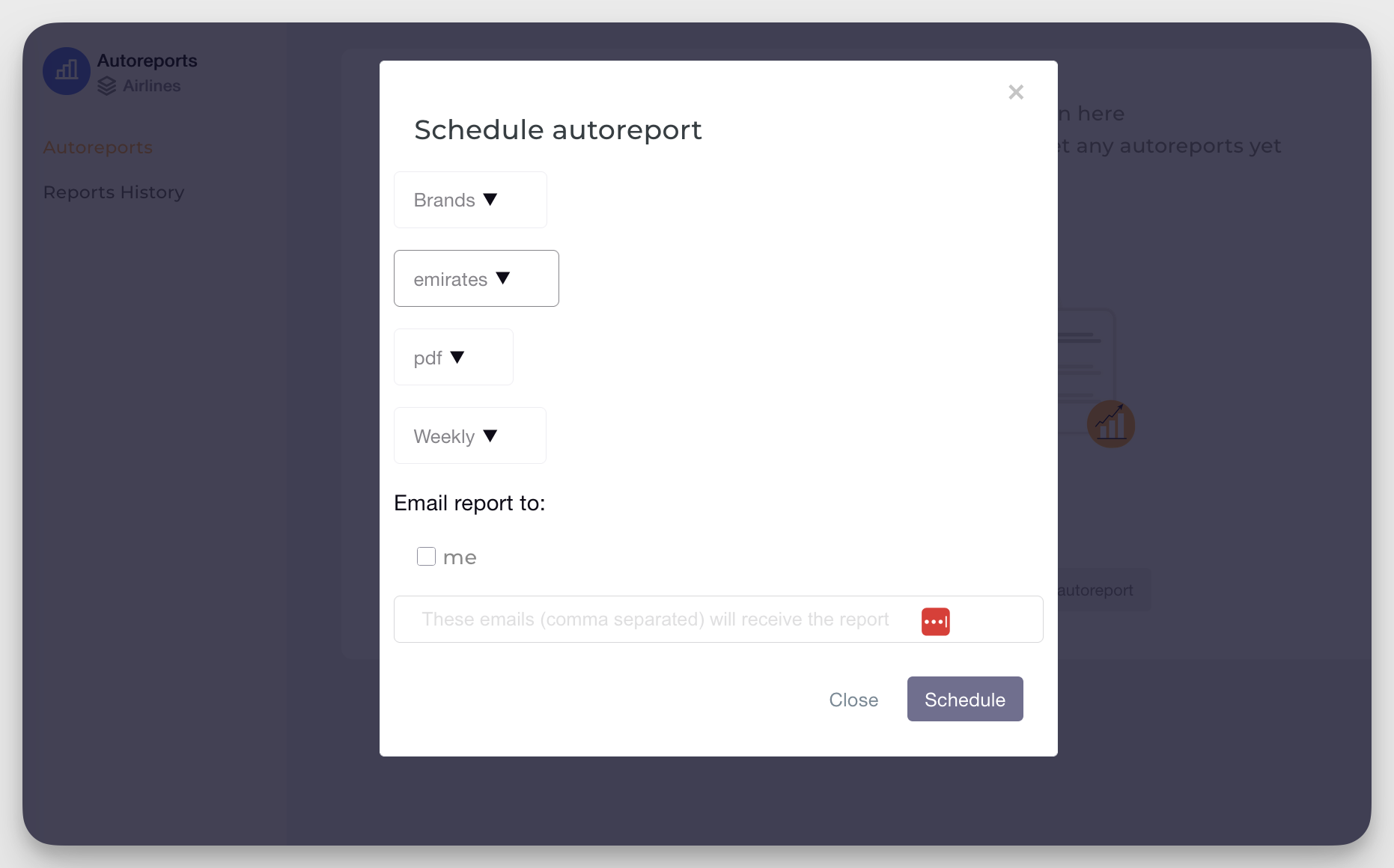
Pros:
- Offers strong competitive analysis to benchmark against industry rivals
- Supports multiple social media platforms for comprehensive monitoring
- Features an intuitive interface that’s easy to navigate and use
Cons:
- Has limited YouTube-specific features, which may restrict in-depth analysis for that platform. You can utilize native analytics and combine Socialinsider to get the best of everything.
Best for: Marketing teams focused on competitive analysis. It helps teams benchmark performance and refine strategy based on competitor data.
Pricing: Socialinsider offers four pricing tiers, and the pricing starts from $82 per month (billed annually).
2. Tubular Intelligence
Tubular Intelligence is an enterprise-grade video analytics platform built for brands. It specializes in deep YouTube insights and cross-platform video data.
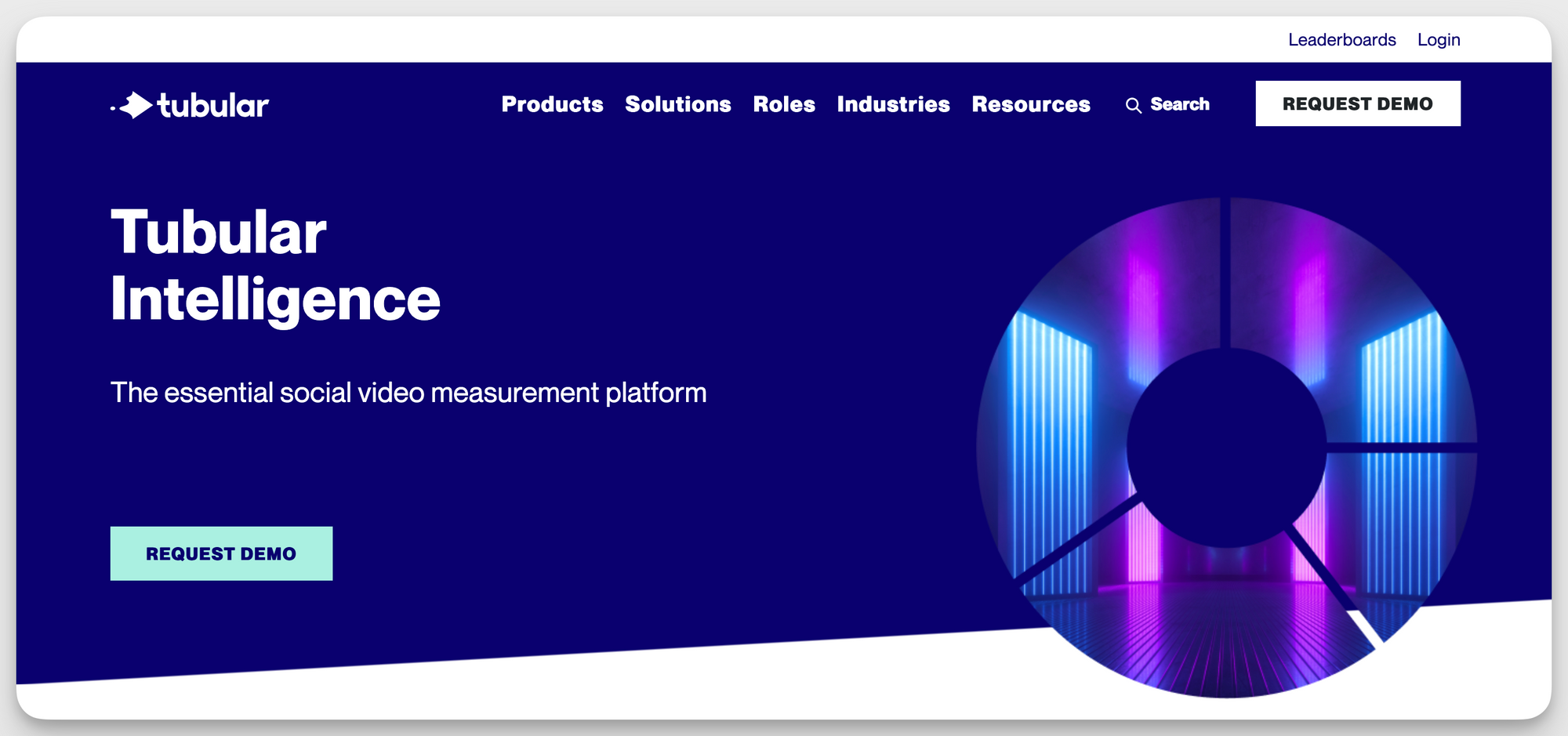
With access to billions of videos and millions of creators, it helps brands uncover trends and track performance. You get clear insights into audience behavior, content effectiveness, and competitor moves.
Its creator and influencer Intelligence also helps brands find the best influencers using performance data, not just follower counts. You can track their engagement, growth, and audience fit for your brand.
Key features:
- Advanced Audience Segmentation: Break down video audiences by age, gender, location, interests, and viewing behavior for precise targeting.
- Cross-platform video performance analysis: Compare and measure content performance across YouTube, Facebook, Instagram, and more in one unified view.
- Predictive analytics and trend forecasting: Anticipate what content, formats, or creators will gain traction before they go viral.
- Custom audience creation: Build tailored audience profiles based on viewing habits and content preferences to inform campaigns.
- Competitive intelligence dashboard: Track competitor video strategies, top-performing content, and share of voice across platforms.
- Brand safety monitoring: Ensure your brand appears in safe, relevant environments by analyzing content context and audience alignment.
Pros:
- Gives clear insights into how videos perform and who’s watching.
- Delivers accurate data that big brands can trust.
- Helps you spot trends before they go mainstream.
Cons:
- Can be very expensive, making it less accessible for smaller teams or budgets.
- Has a complex setup that may require training or support to get started.
- Geared toward large enterprises, so it may not be what smaller brands need.
Best for: Large brands and media companies with a strong YouTube presence who can shell out a lot of money for deep insights.
Pricing: Tubular Labs offers custom pricing.
3. Brandwatch
Ever wondered what people really think about your brand on YouTube? That’s where Brandwatch comes in. It’s an AI-powered consumer intelligence platform that helps you listen to online conversations, especially on platforms like YouTube.

With Brandwatch, you can track mentions, analyze sentiment, and understand trends across videos and comments. It turns massive amounts of data into clear insights you can actually use. Whether you’re launching a campaign or managing a crisis, Brandwatch helps you stay ahead.
Key features:
- Advanced social listening across YouTube: Monitor brand mentions, keywords, and trends from YouTube videos and comments in real time.
- Sentiment analysis and emotion detection: Understand how audiences feel about your brand with AI-driven sentiment and emotion insights.
- Influencer identification and tracking: Discover and track key YouTube creators who influence your audience or industry.
- Crisis monitoring and alerts: Get instant alerts for sudden spikes in negative mentions to respond before issues escalate.
- Custom dashboard creation: Build personalized dashboards to visualize the metrics and insights that matter most to your team.
Pros:
- Uses AI to uncover what people really think and feel about your brand.
- Tracks conversations across YouTube and other platforms in one place.
- Turns complex data into simple, clear visuals you can act on.
Cons:
- YouTube analytics is bundled with other tools, so it’s not fully standalone.
- The platform can be hard to learn if you’re new to it.
Best for: Enterprise brands that need deep consumer insights and strong reputation management across platforms like YouTube.
Pricing: Brandwatch offers custom pricing for its three plans.
4. Quintly (now Facelift Data Studio)
Struggling to measure how your YouTube channel really performs? Quintly dives deep, tracking watch time, engagement rate, subscriber changes, and even audience interaction per video. You can compare these metrics with competitors to see exactly where you stand.
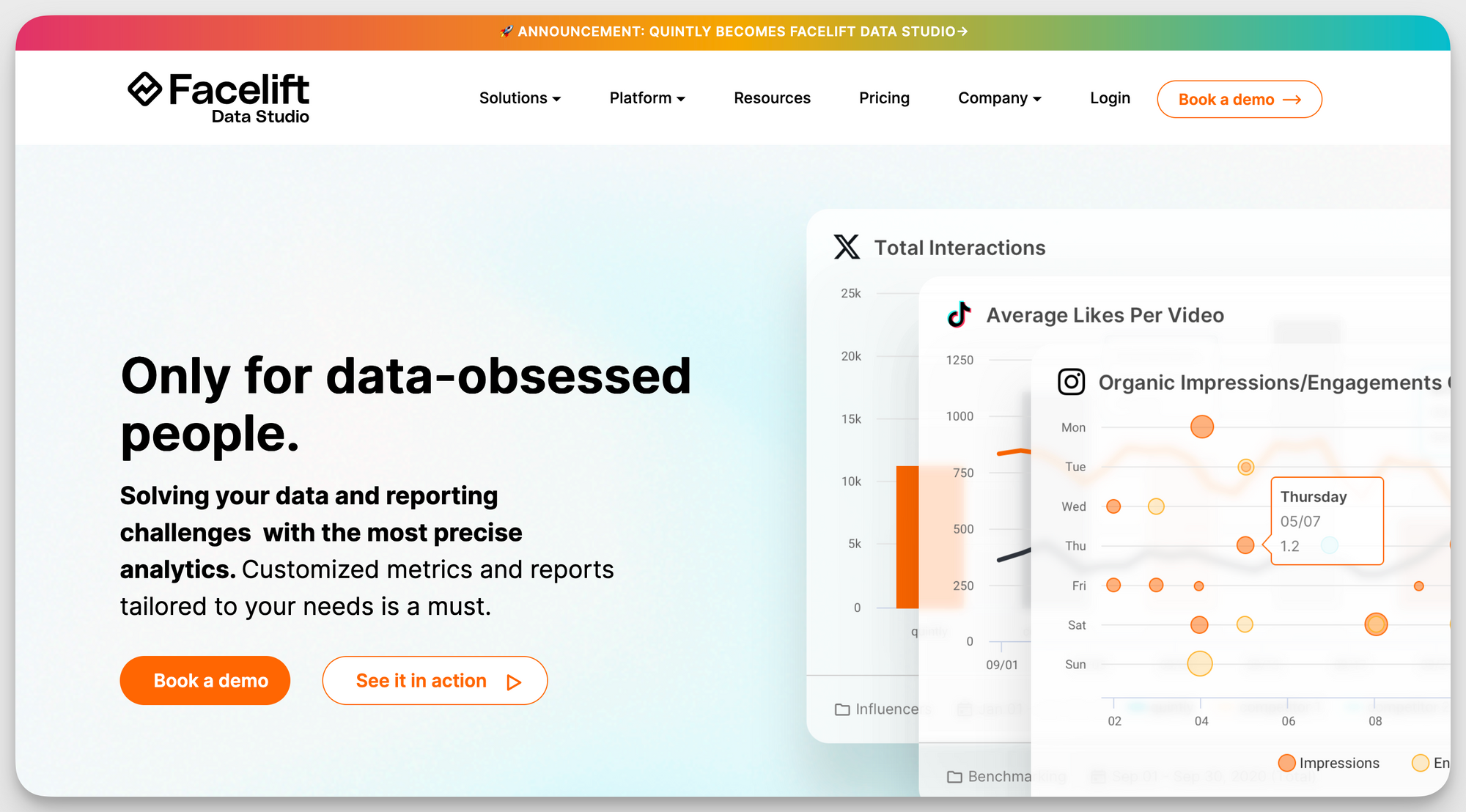
It lets you build custom dashboards. For example, one showing top-performing videos by average view duration.
Moreover, instead of manually creating reports, you can let the tool generate them for you and automatically share them with your management or social media team.
Key features:
- Cross-platform analytics: Track and compare performance across YouTube, Facebook, Instagram, and more, all in one place.
- Automated reporting: Schedule and send professional reports without lifting a finger.
- API access: Pull raw social data into your own systems for deeper analysis or custom tools.
- Custom KPIs: Define and track your own performance metrics to match your unique goals.
Pros:
- Delivers powerful analytics to help you understand and grow your YouTube channel with precision.
- Offers flexible reporting so you can share insights the way your team or clients need them.
Cons:
- Takes time to learn due to its advanced features and setup options.
- Geared more toward enterprise users, which might not suit smaller teams.
- Pricing increases with each social profile, making it costly for multi-channel tracking.
Best for: Large organizations and agencies that need deep, customizable analytics across multiple YouTube and social media accounts.
Pricing: Quintly provides pricing on request for all three of its plans.
5. Unbox Social
Ever wondered how brands know which YouTuber is right for them? That’s where Unbox Social comes in. It’s like a smart assistant for influencer marketing on YouTube.
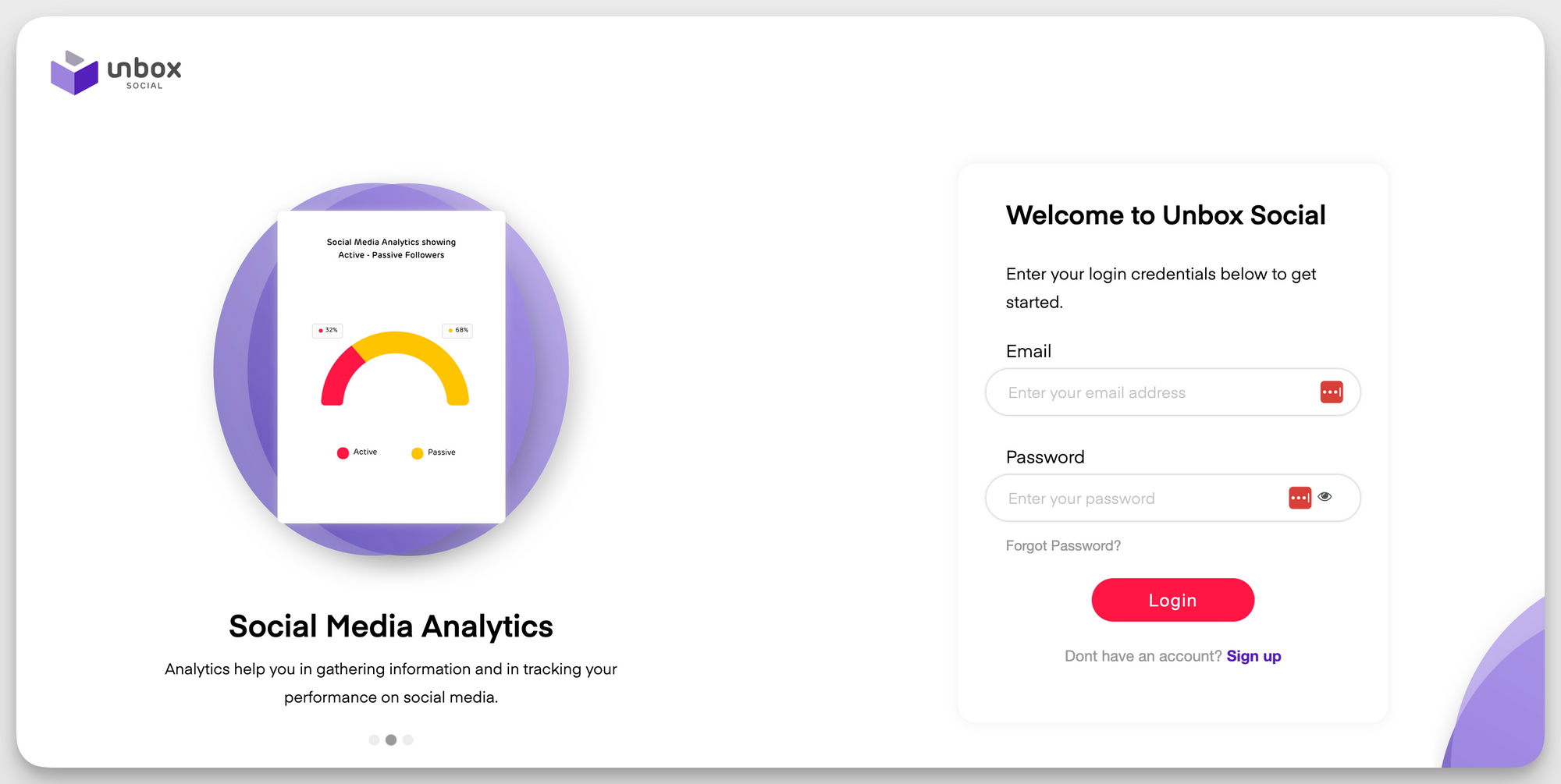
Think of it this way. Picking a YouTube influencer without data is like guessing in the dark. Unbox Social turns on the lights. It helps brands and agencies find the right creators by analyzing things like engagement rates, audience quality, and content style.
You can track how well a campaign is doing, measure ROI, and see what’s working (and what’s not). The platform also gives you an idea of your audience demographics and spread.
Key features:
- YouTube influencer database: Find the right creators fast. Browse a wide range of YouTubers filtered by niche, location, audience size, and more. No more guesswork.
- Campaign performance tracking: See how your campaigns are doing in real time. Track views, likes, comments, shares, and know which videos are truly making an impact.
- Audience analysis: Get to know the creator’s followers. Unbox Social shows insights like age, gender, location, and engagement quality so you can be sure you’re reaching the right people.
- ROI measurement: Know if your investment is paying off. Measure the return on every campaign with clear metrics like cost-per-view, engagement rate, and more.
Pros:
- Provides detailed influencer analytics, including engagement quality, posting habits, and past brand collaborations.
- Helps identify the right YouTube creators using advanced filters and audience insights.
Cons:
- Real-time tracking can sometimes lag, especially with large or fast-moving campaigns.
- Focuses heavily on analytics, offering little support for content planning or creative strategy.
Best for: Influencer marketing agencies offering powerful tools to discover creators, track campaign performance, and deliver in-depth client reports.
Pricing: Unbox Social offers four pricing plans. The basic plan starts from $7 per month (billed annually). Depending on the users and features, the pricing increases.
For SEO and channel growth
6. vidIQ
Struggling to get more views on YouTube? vidIQ helps you fix that. It’s a YouTube SEO and analytics tool made to grow your channel. vidIQ shows you the best keywords to use in your titles, tags, and descriptions.
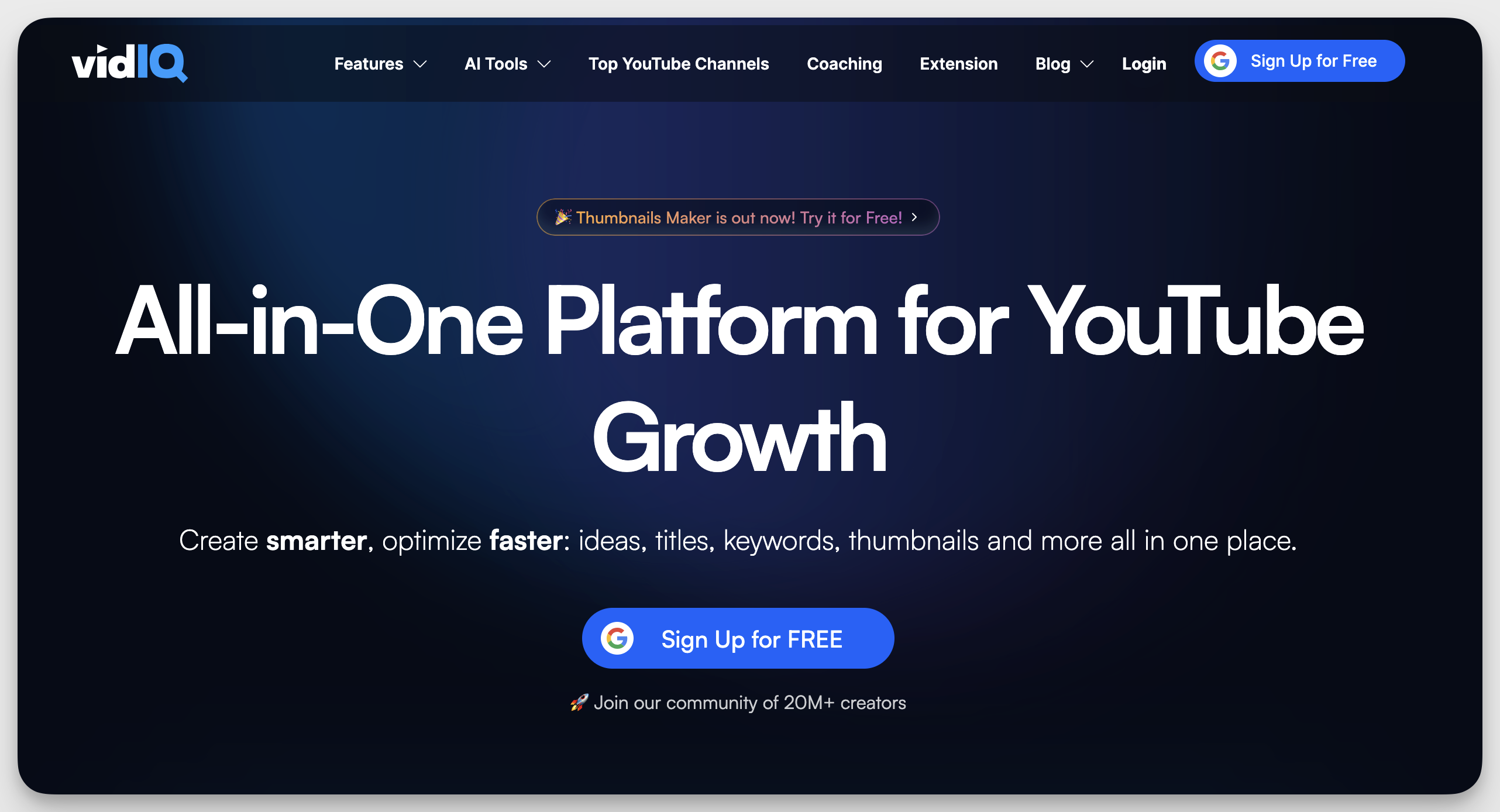
It scores your videos for SEO and gives tips to boost visibility. You can track views, watch time, and even see what your competitors are doing. It also suggests trending topics based on what your audience is searching for.
Moreover, you can also run a brand channel audit to quickly spot what’s working, what needs improvement, and missed opportunities to grow your channel.
Key features:
- Keyword research: Helps you find high-performing keywords your audience is searching for, so you can optimize your titles, descriptions, and content strategy.
- Tag suggestions: Recommends relevant tags to improve your video’s SEO and visibility in YouTube search results.
- Competitor analysis: Lets you track other channels to see what content is working for them, including their top videos, posting frequency, and engagement.
- Basic analytics dashboard: Gives you a quick overview of key metrics like views, watch time, and subscriber growth in one easy-to-read dashboard.
Pros:
- Focuses heavily on SEO to help your videos rank higher and get discovered faster.
- Offers a handy browser extension that shows real-time data and tips right on YouTube.
- Gives helpful suggestions on titles, tags, and keywords to improve video performance.
Cons:
- Advanced features can get pricey, especially for small businesses.
- The interface can feel cluttered with too many pop-ups and tooltips.
Best for: Brands focused on content optimization and SEO to improve video discoverability and grow their audience.
Pricing: vidIQ offers 2 plans — their monthly plan costs $999 per month, and their annual plan costs $416.58 per month.
7. TubeBuddy
Want to save time managing your YouTube channel? TubeBuddy makes it easy. It’s a YouTube-certified tool that helps you handle everything from SEO to video publishing.
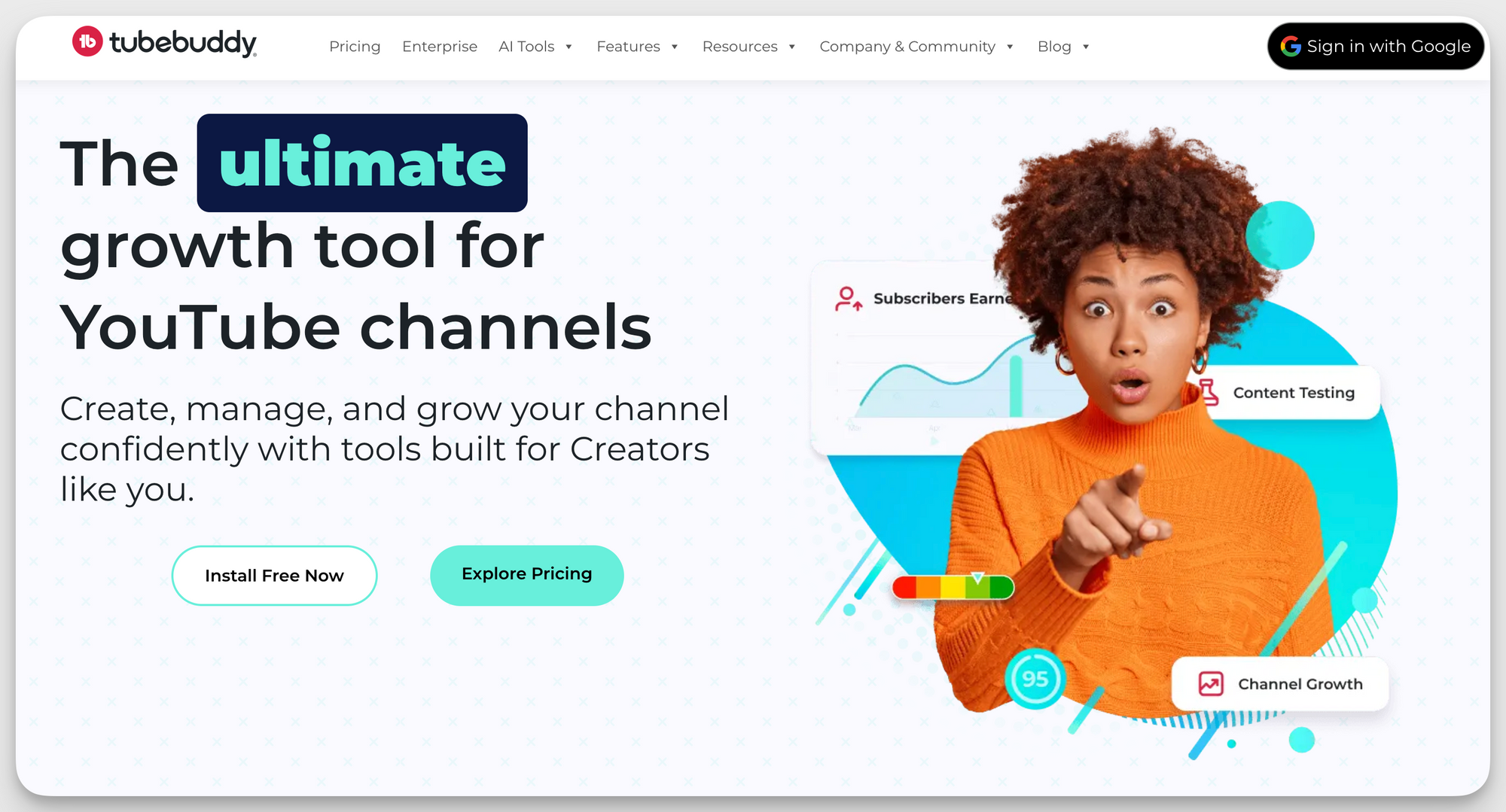
TubeBuddy suggests the best tags and keywords to get more views. It also helps with bulk processing tasks like updating titles or thumbnails. You can track your channel’s growth with clear analytics and compare your stats with competitors.
Key features:
- Bulk processing tools: Save time by updating titles, descriptions, tags, and thumbnails across many videos at once instead of doing it manually.
- A/B testing for thumbnails and titles: Test different thumbnails and titles to see which version gets more clicks and improves your video’s performance.
- Tag suggestions and SEO tools: Get keyword and tag recommendations to optimize your videos for better search rankings and visibility.
- Basic analytics: Track key metrics like views, watch time, and subscriber growth to understand how your channel is performing.
Pros:
- Offers smart SEO tools that help your videos get discovered.
- Features include comment moderation tools to manage engagement efficiently.
- Provides bulk processing to save time on repetitive tasks.
Cons:
- The interface can feel overwhelming with too many options and pop-ups, especially for beginners.
- Some users report that A/B testing results can be inconclusive due to YouTube’s algorithm changes.
Best for: Brands and businesses looking to efficiently manage their YouTube channels and improve video SEO to drive audience growth.
Pricing: TubeBuddy offers two pricing plans. The pricing starts from $3.60 per month (billed annually).
For agencies and brands
8. SocialPilot
Struggling to keep up with how your YouTube videos are doing? SocialPilot gives you the full picture, without the headache. It tracks views, engagement, watch time, and subscriber growth, all in one clean dashboard. No need to jump between YouTube Studio and spreadsheets.

You can see what content performs best and when your audience is most active. It even lets you schedule YouTube posts ahead of time, so you’re always consistent. Whether you’re managing one channel or many, SocialPilot helps you spot trends and make smarter content decisions, without getting lost in the data.
Key features:
- YouTube channel performance tracking: Monitor key metrics like views, watch time, engagement, and subscriber growth to understand what’s working on your channel.
- Multi-account management: Manage multiple YouTube channels or social media profiles from one dashboard.
- Content scheduling with analytics: Schedule YouTube videos in advance and analyze their performance to optimize future content.
- Team collaboration tools: Assign roles, review content, and streamline workflows so your whole team stays on the same page.
- White-label reporting for agencies: Create professional, branded reports for clients without showing the SocialPilot name.
Pros:
- Combines publishing, analytics, and collaboration tools in one platform, making it easy to manage everything in one place.
- Offers affordable pricing plans that suit individuals, small teams, and growing agencies.
- Known for responsive and helpful customer support that quickly resolves issues.
Cons:
- Analytics are basic and lack depth compared to specialized tools.
- The interface can feel cluttered and unintuitive, especially for beginners.
Best for: Small to medium agencies managing multiple YouTube channels that need easy scheduling, performance tracking, and client-ready reporting in one tool.
Pricing: SocialPilot offers four plans, and its agency plan starts from $85 per month (billed annually).
9. Sprout Social
Sprout Social helps brands turn YouTube data into clear, confident action. It digs deep into video performance — tracking views, audience retention, and engagement patterns that actually matter.
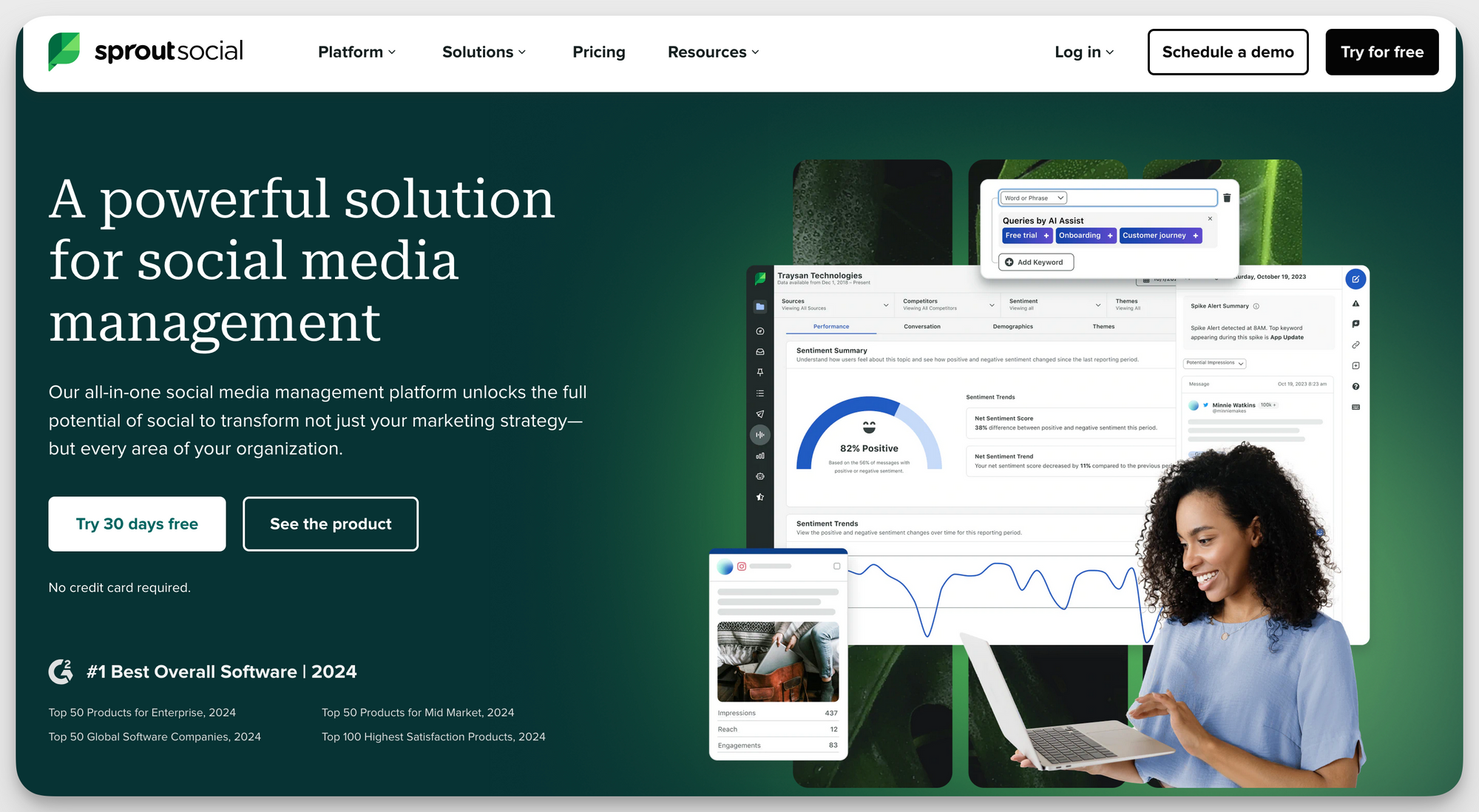
You can monitor how your content stacks up over time, keep tabs on comments, and understand what drives real growth. It’s built for brands that want more than surface-level stats. You can also get powerful reporting and collaborative features so you can easily share data with your team and let them analyze it to optimize strategies.
Key features:
- Advanced YouTube analytics: Offers deep insights into video performance, including watch time, retention, engagement, and audience growth trends.
- Cross-platform reporting: Combines YouTube data with metrics from other social channels, giving you a unified view of your content’s overall performance.
- Team collaboration tools: Lets teams assign tasks, manage comments, and coordinate campaigns without overlapping or confusion.
- Custom dashboard creation: Allows you to build personalized views with the exact metrics and reports your team or client needs.
Pros:
- Delivers professional-grade analytics that go beyond surface metrics to show real performance impact.
- Offers excellent reporting features that are customizable, easy to share, and client-ready.
Cons:
- Comes with a higher price point that may not fit smaller brands.
- Lacks some YouTube-specific features found in more niche tools, focusing more on overall social strategy.
Best for: Agencies and enterprise users who need all-in-one social management and are willing to invest in a premium-priced tool.
Pricing: Sprout Social offers four plans, and its basic one starts from $199 per seat per month. The plan most suitable for agencies starts from $299 per seat per month.
10. Hootsuite
Hootsuite helps you keep your YouTube strategy sharp without losing your sanity. It’s built for marketers who juggle content calendars, comments, and performance reviews. With Hootsuite, you can schedule YouTube videos, monitor engagement, and track how your content performs over time.
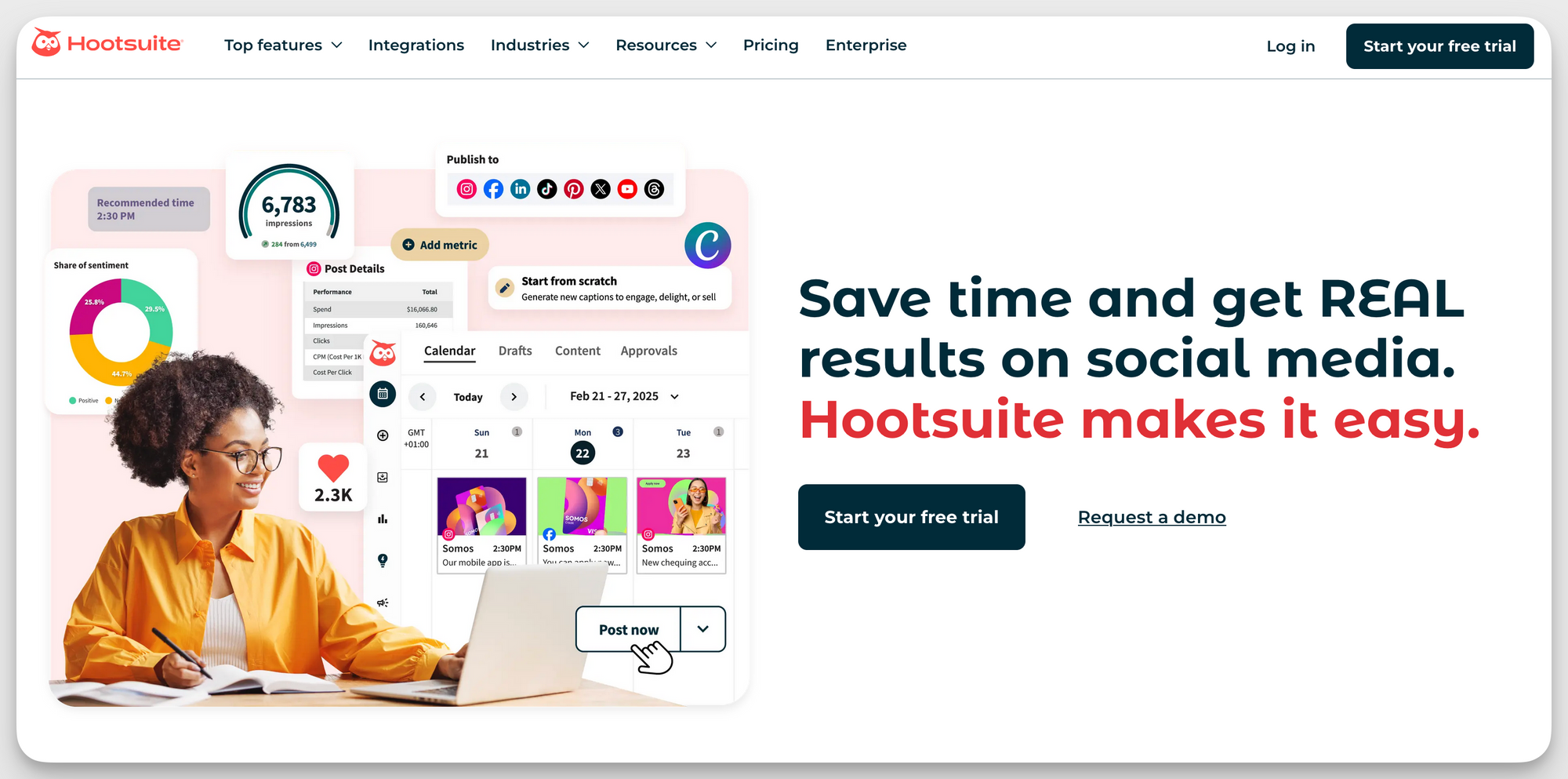
You can also assign comment responses to team members, dig into what’s resonating, and even spot when your uploads are starting to trend.
Key features:
- Cross-platform analytics: Tracks performance across YouTube and other social channels to compare content impact and audience engagement in one place.
- Scheduled reporting: Automatically sends performance reports at set intervals, saving you time and keeping stakeholders in the loop.
- Team collaboration: Let teams assign tasks, manage comment replies, and coordinate publishing, so nothing slips through the cracks.
Pros:
- Helps teams work better together with clear task assignments and approval flows.
- Offers reliable tools for planning and publishing YouTube content consistently.
Cons:
- Advanced analytics are limited for YouTube compared to dedicated platforms.
- Bulk scheduling can be tricky or limited for video content.
Best for: Brands and teams that need streamlined, multi-platform social media management with YouTube included in a unified workflow.
Pricing: Hootsuite’s standard plan starts from $99 per month (billed annually), and it offers a total of three pricing plans.
YouTube analytics tools comparison table
How to choose the right YouTube analytics tool?
Before you zero in on any tool, I recommend going through this list and then making a decision:
- Assess your needs and goals: Start by identifying what you want to track (subscriber growth, video engagement, SEO, or competitor performance) so you can choose a tool aligned with your strategy.
- Data accuracy and reliability: Make sure the tool pulls verified YouTube data and updates it regularly to avoid misleading insights.
- User interface and ease of use: A clean, intuitive interface helps you access the right insights quickly without a steep learning curve.
- Reporting and export capabilities: Look for features like automated reports, custom dashboards, and export options (PDF, CSV, XLS, PPT) to simplify sharing and analysis.
- Integration and API access: Choose a tool that integrates well with your existing platforms and offers API access for custom workflows.
- Customer support and resources: You don’t want to run into roadblocks with the tool. And even if you do, you need reliable support and resources to pull you out.
I recommend taking your selected tool for a free ride (most tools offer a free trial) and then upgrading when you think you have made the right choice.
Final thoughts
Choosing the best YouTube analytics tools 2025 comes down to understanding your goals and finding the right features to match. Whether you’re focused on growing subscribers, improving content performance, or staying ahead of competitors, the right tool makes all the difference.
You can get started with native analytics to get an idea of how you can track different metrics. Then level up with third-party tools to get deep into competitor insights and optimize content strategies.
Ready to make YouTube work for your brand? Get a free trial of Socialinsider to get in-depth competitive insights.
FAQs about YouTube analytics tools
1. What is the best YouTube analytics tool?
There is no single “best” YouTube analytics tool—it depends on your needs and budget. For most brands, YouTube Studio Analytics (the native, free tool) is the essential starting point, offering real-time analytics, audience demographics, traffic sources, and watch time reports. Beyond that, many brands use 1-2 complementary tools, depending on their needs and goals.
2. How to check the analytics of a YouTube video?
For your own videos, use YouTube Studio (desktop or mobile app). Go to your channel, select the video you want to see the analytics for, and click on the “Analytics” tab for a detailed breakdown of views, watch time, engagement, traffic sources, and audience demographics.
For any public video, use a third-party tool to see public metrics such as views, likes, comments, engagement rate, or tags. Keep in mind, though, that data for public videos is more limited than the data you can gather for your own videos.
3. How much does YouTube pay per 1000 views?
CPM (cost per mille, cost per thousand impressions) varies by country, niche, content type, and audience location. Tech, finance, and business channels often command higher CPMs.
As a starting point, in the US and similar markets, typical earnings are $10–$30 per 1,000 ad views (CPM), but for general video views, the real average is closer to $5–$7 per 1,000 views.
4. Is YouTube Analytics free?
Yes, YouTube Studio Analytics is completely free for all channel owners and is built into YouTube. Many third-party tools also offer free plans with basic analytics, but advanced features and competitor tracking usually require a paid subscription.
5. How often should I check my YouTube analytics?
Best practices for analytics review frequency:
- Daily: check real-time views and comments for new uploads to spot immediate performance and engage with your audience, and monitor for sudden spikes or drops that might require urgent action.
- Weekly: review channel growth (subscribers, watch time, top-performing videos), analyze traffic sources and engagement trends, and adjust content strategy based on what’s working.
- Monthly: deep-dive into audience demographics, retention, and long-term trends. Compare month-over-month performance and set goals, and evaluate the success of content themes, posting schedules, and experiment results.
6. Can I track competitor YouTube analytics?
Yes, but with limitations. You can use third-party YouTube analytics tools to track public metrics such as competitor views, subscribers, video uploads, and engagement (likes/comments), but you can’t get private data such as watch time, retention, revenue, or detailed audience demographics.
7. What’s the difference between YouTube Analytics and third-party tools?
The main difference lies in how you use each tool. You can use YouTube Analytics for in-depth, accurate data for your own channel, and third-party tools for competitor benchmarking, keyword research, and broader content strategy insights.
8. How accurate are third-party YouTube analytics tools?
Third-party YouTube analytics tools are generally accurate when reporting public data such as views, subscribers, and likes, since these metrics are gathered directly from YouTube via the API. However, for advanced metrics like estimated earnings and engagement rates, the figures provided are only estimates—actual earnings, watch time, and retention data remain private and are accessible only to the channel owner.
Additionally, third-party tools may experience data delays and can lag behind the real-time information available in YouTube Studio, particularly for recent uploads or rapidly changing statistics. Most of these tools rely on the YouTube API, which can limit or delay certain metrics, and discrepancies may occur if YouTube updates its API or restricts access.
Analyze your competitors in seconds
Track & analyze your competitors and get top social media metrics and more!
You might also like
Improve your social media strategy with Socialinsider!
Use in-depth data to measure your social accounts’ performance, analyze competitors, and gain insights to improve your strategy.





